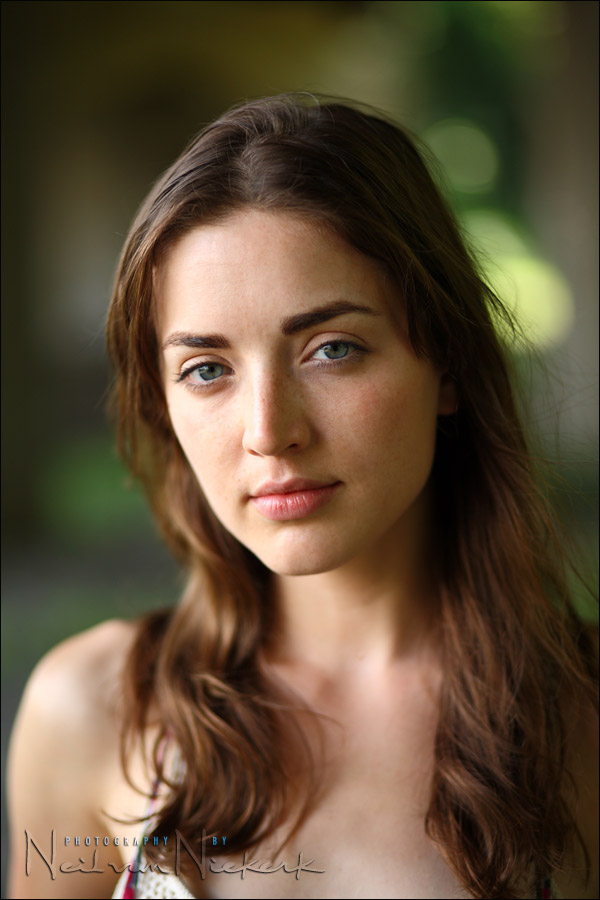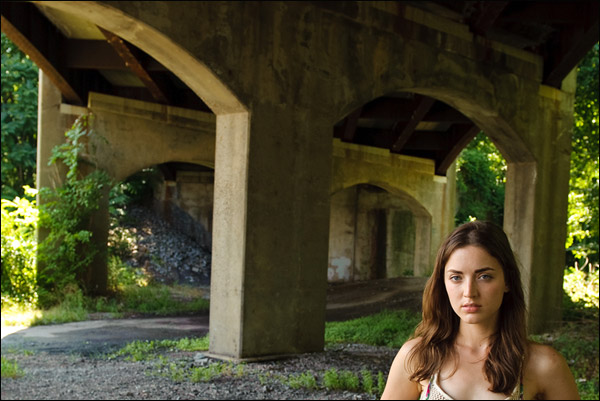
photographing people – available light portrait
While unloading lighting gear from the van to shoot a last few images for a certain section for my next book, I turned around and noticed the way the light fell on Anelisa. Beautiful portrait light. The (cropped) pull-back shot will show why ..
We were parked under a bridge. The light now comes in from the side, but high up. This means the light isn’t top heavy, and you won’t get heavy shadows under the eyes. So with slight positioning of our model, Anelisa, we have soft light that comes in from a perfect angle – from the side and above at around a 30 to 45 degree angle.
This is the kind of thing we can actively look for when photographing someone. A few steps inside a doorway. Or a few steps under a carport. Or even a few steps between trees in a forest or park. Just enough to hide the light coming from above on a cloudy day, or from the sun.
The photo was taken with the classic Canon 5D, and the Canon 85mm f1.8 (B&H)
Camera settings: 1/400 @ f2 @ 200 ISO; no flash, just available light.
photographic composition – looking at the background
In framing the portrait above, I moved a little until I liked the way Anelisa was framed against the out of focus high-lights in the background. This relates directly to a previous post on how we frame our subject when shooting – we purposely look for at the background, and how we position our subject and ourselves in relation to the background. In that sense again, the photo at the top, while it is an impromptu portrait, it isn’t accidental in its composition. The composition was done with purpose.
And to give you an even better idea of how ugly our surroundings were, click on the pull-back shot to see the entire area. But in framing tight with a short telephoto lens; and using shallow depth of field; we’re able to eliminate everything that doesn’t add to the final image. That’s the essence of composition – the photographer includes what adds to the final image, and eliminates everything that doesn’t add something.
choice of lenses for available light portraits
A final comment about the lens – the Canon 85mm f1.8 (B&H) – it’s an exceptional lens for the image quality vs price. Many aspiring photographers who are using the slow f5.6 zooms, might think that photographs where the use of shallow depth of field is out of their reach, should strongly consider an 85mm f1.8 lens. It is quite affordable, and will give you access to this kind of simple portraits, where attention is placed entirely on the subject. For the Nikon shooters, the Nikon 85mm f1.8 (B&H) is the equivalent. Of course, the ‘big guns’ here are
the legendary Canon 85mm f1.2 (B&H), and the stellar Nikon 85mm f1.4D AF (B&H).

very nice civil portrait! Could you please tell what aperture is used? My gues is at F3.2 but would like to be sure… thanks a lot.
Hey Neil,
thanks for shairing ‘the essence of composition’. I already learned a lot from your blog!
I recently purchased the Canon 85mm f1.8 and it’s a very nice lens to work with.
Greetz from Belgium
Eefje
Neil,
You always make the simplest subject intriguing.
For those reading comments, the buttery shallowness from these lenses adds such a painterly quality to the shot… both within the face and beyond into the background. We always hear about shaping with light… but this is shaping and sculpting with aperture.
Hi Neil
About your lens choice…
I use the 50mm 1.8 but I use a 1.6 crop sensor body.
Would the 80mm that results from that situation have the similar effect to the 85mm on a full frame?
Nice shot and composition. Yeah, the pull-back shot is a mess.
Is this a switch back to Canon?
Niel,
Is there a specific reason why you shot with the 5D and not the typical D3? I would say “maybe it was just what was in his bag,” but that too implies a specific choice. I’m sure you don’t play camera gear bingo before heading out on a shoot.
I’ve been considering picking up the 85 f/1.8, but have seen a lot of mediocre shots with it (probably all from mediocre photographers). That top shot may have just sold me (when the budget allows).
Steve
Good post Neil. You are very good at teaching me to see what I am looking at.
BTW – I don’t have many lenses, but I do have that 85mm lens and it is wonderful. I call it my “magic” lens.
Neil,
The shot above looks like from a photoshhot, but i guess it was a casual shot for you and it was this good. You are too good. Do you ever use a 50mm,1.2 Nikkor. Is it any good for portraits. I have a 50mm, 1.2AF lens. Where can i put it to use.
Neil, I’ve thought about picking up the 85mm 1.8 (Nikon), but I recently took the plunge on the new 70-200 2.8 VRII, which I know you love. Do you think this same portrait would’ve worked as well with that lens?
The big big gun is the 135L. Fabulous lens! I have the 85mm 1.8 too, also a fabulous lens as long as you don’t hit the high contrast purple/green fringing which is quite severe.
Thanks for the tip in looking for out of focus hilight for background. that’s a very useful tip for this type of shots.
Looking at the pull back, this is almost a window light situation uh?
Very inspiring article and photo.
So even on a cloudy day, no direct sun light on the model, you would still move him/her under the bridge?..
There is something very special about that portrait. Simple. Beautiful. Elegant. Real.
I’m liking the sharpness of primes the more I see them, no matter the length of them. So sharp!
But I’m happier to hear that there’s another book in production. Yay! Can you say what the topic of it is?
As always, I appreciate the information you share and demonstrate on your blog, the behind the scenes info about the location. It is always so helpful. I know the book will be great.
Neil used the 5D to show how ‘even a Canon can look good in the hands of a pro’. kidding!! ;)
In regards to Chip’s question: I just got finished doing some fine focus adjustments with my 85f/1.4 and my 70-200f/2.8vrII, I was having some issues with my D300s back-focusing. And after pixel peeping for the process, I’ve concluded that although the 85f/1.4 does have that creamy bokeh and that ‘3d look’ wide open, that new 70-200vrII is really, insanely sharp. That with it’s VR and fast focus, I’m actually going to relegate the 85 to the back of the bag except for special circumstances.
Hi Neil,
Just wanted to say thanks for all your wonderful posts – the quality you post, both in terms of the photos themselves and the information you provide are nothing short of exceptional. Love reading your stuff, one of the first things I look for each day in my RSS feeds.
Hey Neil,
I can’t wait for your new book! A question about the image you posted above: I noticed that the girl’s face is in focus but her body goes softly out of focus. What sort of pose did you have her do to create that effect. Are you having her lean in forward at her abdomen? Or did you just have her stand however she wanted?
-Nick
you make this looks easy
genius how you compose the bg
Hi Neil,
I just want to thank you for sharing your knowledge ! I’m a french follower of your work and you have taught me so many think ! I’ve just bought your book which is an excellent reading !
thanks for all !
Neil:
This may be a stupid question, but how did you meter the available light? Would you spot meter the highlights on the skin and let the remaining tones fall where they may? What is the best technique without an incident meter.
Lovely work and thanks for the insights!
Just found your site, and what a wonderful and informative site it is. Keep up the great work.